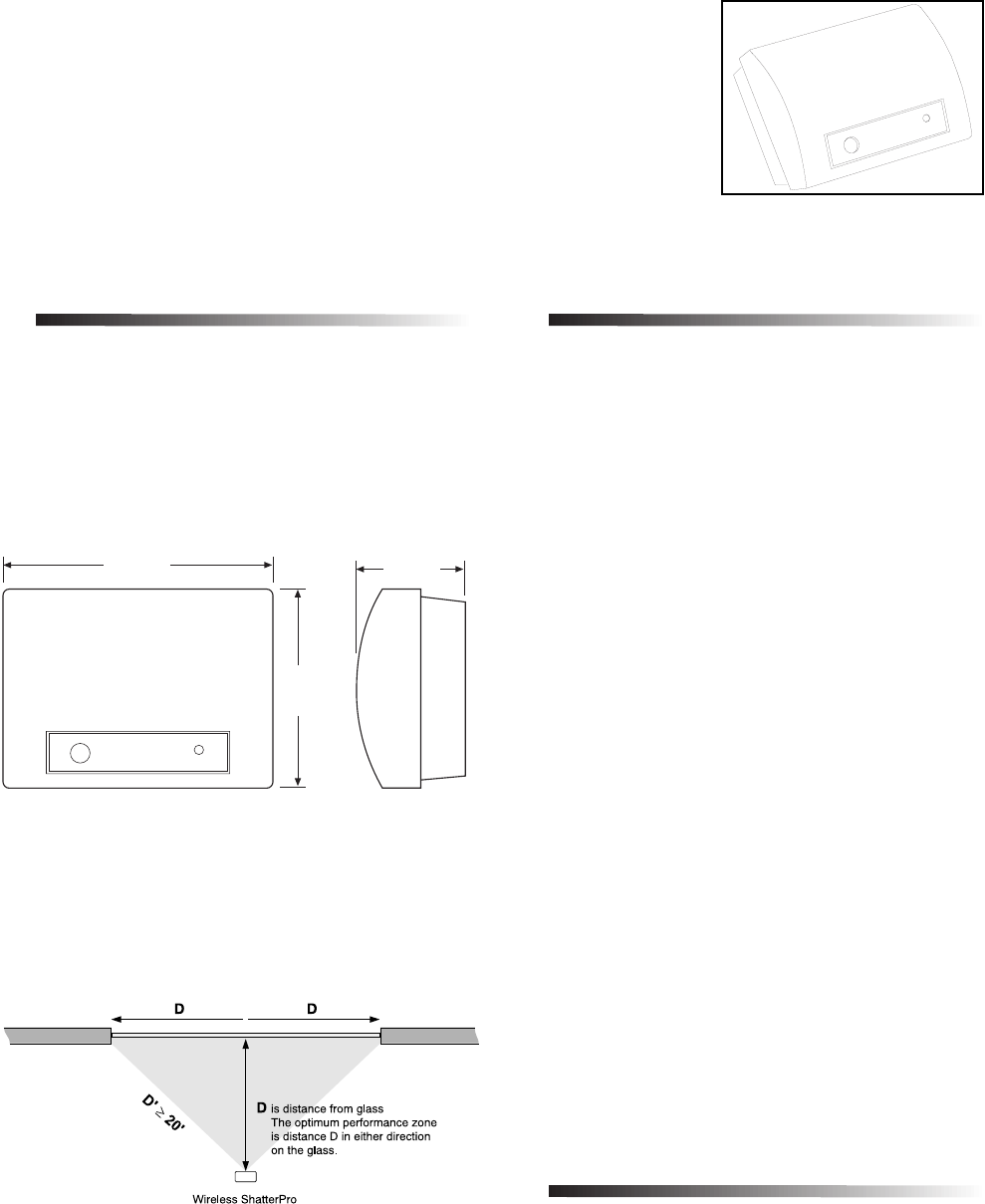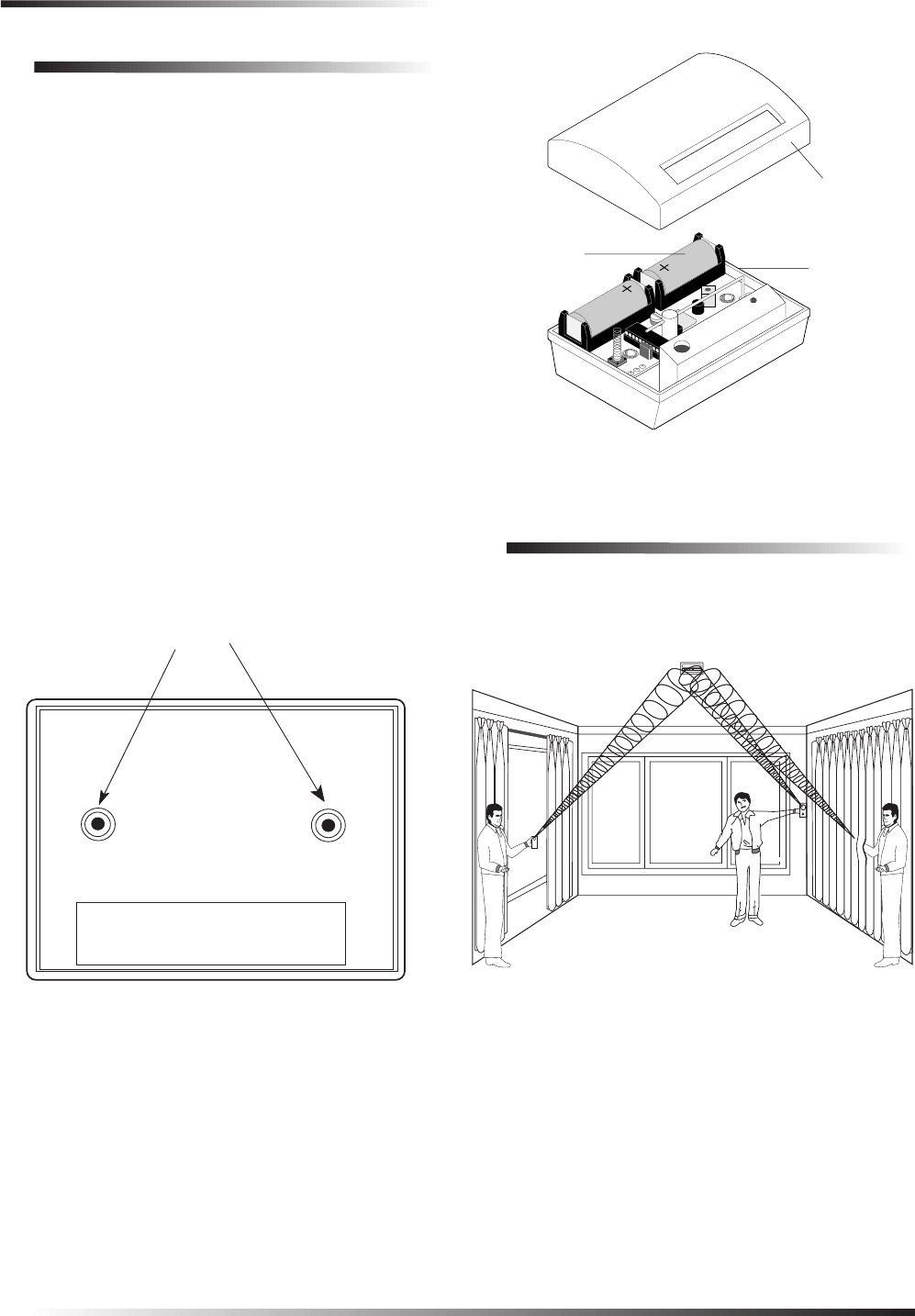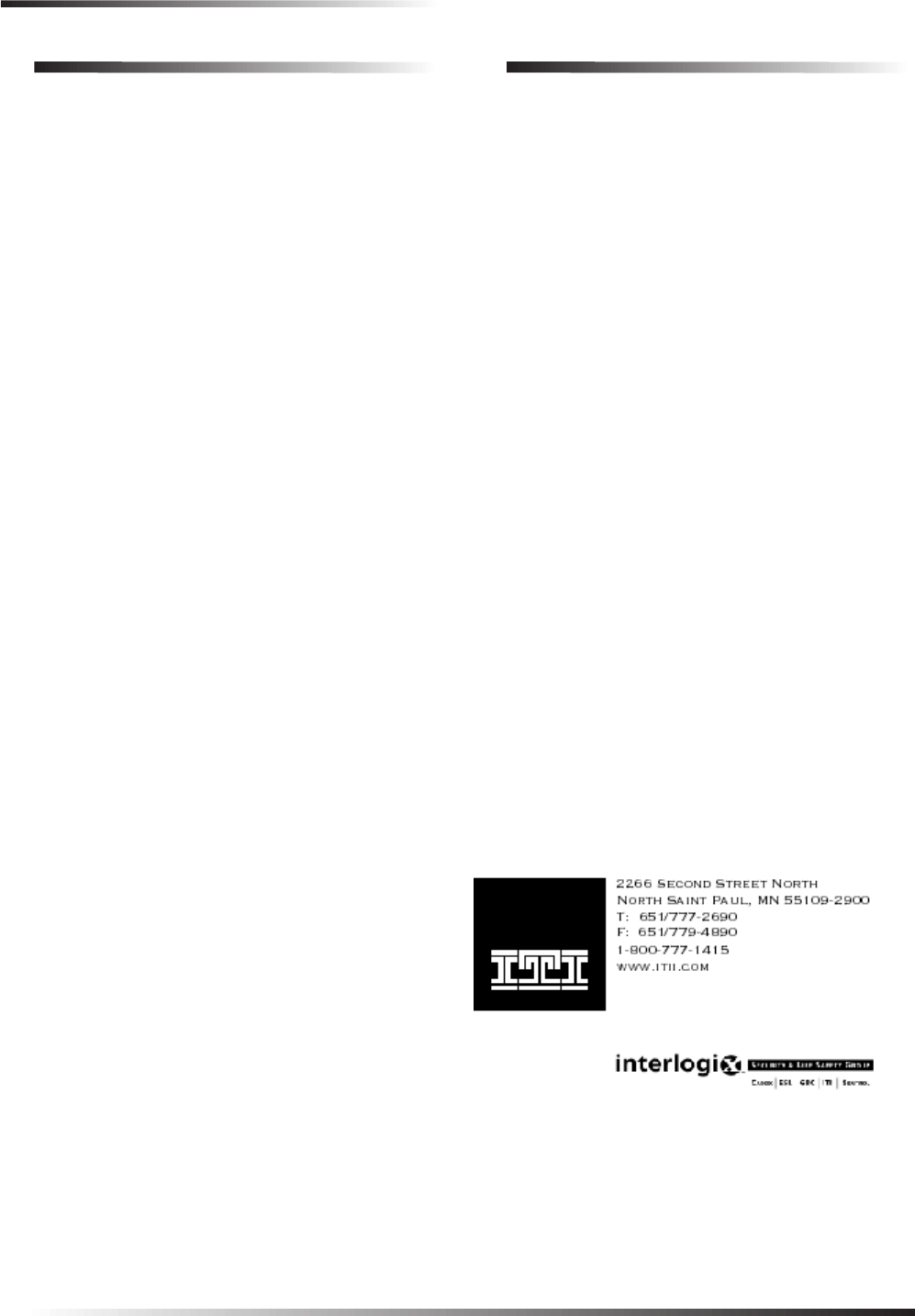UTC Fire and Security Americas 799A-SOUND Shatter Pro (Glass Beak Detector) User Manual temptest2
UTC Fire & Security Americas Corporation, Inc. Shatter Pro (Glass Beak Detector) temptest2
User Manual

ShatterPro™
Glass Break Sensor
Installation Instructions
ITI Part Numbers 60-873-95
Document Number 466-1841 Rev A
November 2000
Product Summary
The Sentrol/ITI ShatterPro™ omnidirectional glass-break
sensor provides 360 degree coverage. It can be mounted
on the ceiling, or on the opposite wall, or on adjoining
walls. It has a range of up to 20 feet for glass panes 1’ x 2’
(0.3m x 0.6 m) or larger.
Figure 1. The ShatterPro Glass Break Sensor
The maximum detection range is 20’ (6 m) for plate,
tempered, laminated and wired glass. For armor-coated
glass, the maximum detection range is 12’ (3.65 m).
Coverage is measured from the sensor to the point on the
glass farthest from the sensor (see D and D’ in Figure 2).
See “Specifications” for recommended glass thickness.
Figure 2. Optimum performance zone
Note
ShatterPro may not consistently detect cracks in
glass, or bullets that break through the glass.
Glassbreak sensors should always be backed up
by interior protection.
Installation Guidelines
❑For best detection, avoid installing in rooms with
lined, insulating, or sound deadening drapes or rooms
with closed wooden window shutters inside.
❑Don’t use near an air compressor. A blast of
compressed air may cause a false alarm.
❑Avoid stairwells, glass booths, and all rooms smaller
that 10’ x 10’ (3 m x 3 m).
❑The Pattern Recognition Technology™ of the
ShatterPro ignores most false alarm sounds. Some
sounds can duplicate the glass break pattern the
ShatterPro detects, however, so the ShatterPro works
best in rooms with only moderate noise. Avoid rooms
where white noise, such as a fan, is present. Avoid
rooms with noisy areas or multiple noise sources such
as small kitchens or bathrooms, garages, etc.
Note
For glass break protection in these applications
(where Shatterpro is not appropriate), use shock
sensors on the windows or window frames.
❑Avoid adding (learning) the sensor into 24-hour sensor
groups, where the sensor will be armed even when the
room is in use. Like a motion detector, a glass break
sensor may be tripped when occupants are in the
protected area. Adding the ShatterPro to a perimeter
sensor group, which is armed only when the perimeter
doors and windows are armed, will help prevent false
alarms.
❑Do not install in humid rooms. The ShatterPro is not
hermetically sealed. Excess moisture on the circuit
board can eventually cause an electrical short and
possibly a false alarm.
❑The sensor can be mounted as close as 3.3’ (1 m) from
the glass.
Tools Needed
❑Phillips screwdriver
❑Sentrol 5709C hand-held tester
4.24"
10.8 cm 1.70"
4.3 cm
3.13"
8.0 cm
Front View Side View

2
Installation
Use the following procedure to install the ShatterPro.
1. Choose a mounting location. Since the sound of
breaking glass travels straight out from the broken
window, the best location for mounting the sensor is
the wall opposite the window--assuming the glass to
be protected is within the sensor range and line of
sight. The ceiling and adjoining (side) walls are also
good sensor locations. A ceiling mounted sensor will
have better detection if located 6-10’ (2-3 m) back
from the glass rather than directly above the glass.
Important !
DO NOT EXCEED THE 20’ MAXIMUM
DETECTION RANGE OF THE SHATTERPRO.
While the sensor may function beyond the 20’
range, it could miss a minimum output glass-
break. Furthermore, changing conditions in the
room, such as rearranging furniture, could reduce
the range of the sensor back to 20’.
2. Remove the cover from the ShatterPro base. Hold the
base against the wall or ceiling at the desired mounting
location. Insert screws through the two mounting holes
in the base to attach it to the mounting surface.
Mounting holes
Figure 3. Mounting holes (back view of the ShatterPro)
3. Insert two 3V batteries as shown in Figure 4
Figure 4. Battery installation
Testing the ShatterPro
Pattern Recognition Technology™ of the ShatterPro
ignores most false alarm sounds, including glass-break
testers, so the ShatterPro must be set to “test mode” during
Figure 5. Testing the ShatterPro
the following procedure (see step 2). When the sensor is in
test mode, processing of the glassbreak pattern in the upper
and lower frequencies is disabled. The ShatterPro is then
listening only for the mid-range frequencies, which the
tester reproduces. It is these frequencies that determine the
sensor detection range.
Cover
Base
3V Batteries

3
The ShatterPro is designed to detect the breaking of
framed glass mounted in an outside wall. Testing the
sensor with unframed glass, such as broken bottles, etc.,
may not trip the sensor. Use the Sentrol 5709C hand-held
tester and the following procedure to test the ShatterPro.
1. Set the tester to “tempered glass.”
Note
The 5709C tester has a different setting for each
type of glass. You should always set the tester
for tempered or laminated glass (either is correct
and both have the same range) unless you are
certain that all the glass to be protected is plate
glass.
2. Hold the tester speaker directly on top of the sensor
and activate the tester. The sensor will alarm, then it
will go into test mode for one minute. While in the test
mode, the LED on the sensor will blink continuously.
Note
Extend the test mode time by activating the
tester at least once a minute.
3. Holding the tester near the surface of the glass and
behind any closed drapes or blinds, aim the tester at
the ShatterPro and hold down the test button (see
Figure 5).
Note
Remember, the ShatterPro should not be installed
in rooms with lined, insulating, or sound
deadening drapes or rooms with closed wooden
window shutters inside.
4. Observe the LED on the sensor. If the sensor is
detecting the tester signal, the LED will remain on but
will stop blinking momentarily. This indicates the
sensor is mounted within range and is working
properly.
Note
If the sensor LED blinks continuously when the
test button is pressed, the sensor is not detecting
the tester signal. Replace the tester battery if you
suspect it is not producing a strong signal. If you
are certain that the tester signal is strong,
reposition the sensor closer to the window and
retest. Add more sensors if necessary to achieve
complete coverage.
5. The sensor will automatically exit test mode if it does
not sense any signals for 1 minute.
The “Hand Clap” Test
You can test the ShatterPro without enabling the test mode
by clapping your hands loudly under the sensor. This
sound will not trip the alarm, but the sensor LED will blink
twice. This is a signal that the sensor has power and that
the microphone and circuit board are functioning.
Adding the ShatterPro to Panel
Memory
The following procedure is a general guideline for adding
(learning) the sensor into panel memory. Refer to your
panel installation instructions or reference manual for
complete details.
1. Set the panel to Program mode.
2. Proceed to the LEARN SENSORS menu.
3. Select the appropriate sensor group and sensor
number.
4. Trip the tamper switch on the sensor.
5. Repeat the above steps until all sensors are added
(learned) into the panel.
6. Exit Program mode.
Testing the System
The following steps describe general guidelines for testing
the sensor. Refer to your panel installation instructions or
reference manual for complete details.
1. Set the panel to the Dealer Sensor Test mode.
2. Use the hand-held tester to trip the sensor.
3. Listen for status beeps (or a voice message) to indicate
that the panel is receiving transmissions from the
sensor
OR
Look for a message on the touchpad display.
Note
Refer to you panel installation instructions for
troubleshooting information.

4
Specifications
Compatibility 60-873-95: All ITI 319.5 MHz
Learn Mode™ panels
Housing material: Flame retardant ABS
Dimensions: 4.24” (10.8 cm) length
3.13” (8.0 cm) width
1.70” (4.3 cm) depth
Operational voltage: 2.6 to 4.5 VDC
Current draw: 26µA typical average
Battery Life: 5 years typical
Batteries: (2) Duracell DL 123A 3V Lithium
Transmitter Frequency: 319.5 MHz
Transmitter Conditions: Alarm, Tamper, Low Battery
Supervisory
RF Immunity: 20V/meter 1MHz to 1000 MHz
Microphone: Omnidirectional electret
Operating Temperature Range:
32° to 120°F (0° to 50°C)
Storage Temperature Range:
-30° to 140°F (-34° to 60°C)
Max. Humidity: 90% Relative Humidity (non-
condensing)
© 2000 Interlogix, Inc.
Interlogix, Learn Mode, and Pattern Recognition Technology are
trademarks of Interlogix, Inc. ITI, Sentrol, and ShatterPro are registered
trademarks of Interlogix, Inc.
Protected under US and foreign patents including: 3,863,250;
4,745,398; 4,837,558; 4,885,713; 5,192,931; 5,805,063; 5,776,206;
5,872,512; 5,942,981; and other patents pending.
Notices
This equipment has been tested and found to comply with the limits for
a Class B digital device, pursuant to Part 15 of the FCC Rules. These
limits are designed to provide reasonable protection against harmful
interference in a residential installation.
This equipment generates, uses and can radiate radio frequency energy
and, if not installed and used in accordance with the instructions, may
cause harmful interference to radio communications. However, there is
no guarantee that interference will not occur in a particular installation.
If this equipment does cause harmful interference to radio or television
reception, which can be determined by turning the equipment off and
on, the user is encouraged to try to correct the interference by one or
more of the following measures:
❑Reorient or relocate the receiving antenna.
❑Increase the distance between the equipment and receiver.
❑Connect the equipment into an outlet on a circuit different from
that to which the receiver is connected.
❑Consult the dealer or an experienced radio/TV technician for help.
This device complies with Part 15 of the FCC Rules. Operation is
subject to the following two conditions: (1) This device may not cause
harmful interference, and (2) this device must accept any interference
received, including interference that may cause undesired operation.
FCC ID: B4Z-799A-SOUND